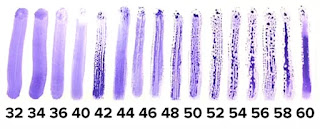Accu dyne test. #Accudyne pic.twitter.com/4okgNbexwA
— Excel Laboratories (@excellabindia) August 18, 2024
Dyne testing is a method for measuring the wetting tension of a solid by determining the minimum surface tension of a specific liquid mixture that allows it to remain spread on the solid’s surface. This approximates the amount of energy required to spread other fluids across the surface and is expressed in units of surface tension (dynes per centimeter, or dynes/cm). This technique is outlined in ASTM D2578, "Standard Test Method for Wetting Tension of Polyethylene and Polypropylene Films.
The higher the dyne/cm value achieved, the higher the wetting tension of the solid surface. Higher wetting tensions, which approximate surface energies, are generally associated with higher rates of successful adhesion.
Although the technique is only considered appropriate for polyethylene and polypropylene films, for years, dyne testing has been the prevalent approach to assessing the cleanliness and surface energy of a wide range of material surfaces in terms of quality. Their widespread use and affordability have made them a popular choice among manufacturers despite their lack of precision, potential damage to material surfaces, and risk to users. While the science supporting dyne measurements as outlined in the ASTM standard is reliable, their application in a manufacturing setting and on other materials does little to avert or mitigate adhesion failure.
Dyne testing is based on the concept of surface energy or wettability, a process directly related to a surface’s adhesive potential. When a substance interacts with a substrate or material, it can reveal information about the material’s surface energy. The response of the dyne solution will vary depending on the surface energy.
When a dyne solution is applied to a surface, it can either form a continuous film or break up into droplets. The user makes this evaluation, and depending on the way the solution is applied, the condition of the applicator, the surface texture, lighting, and contrast, etc., it can be a rather subjective decision. If beading occurs, this signifies lower wetting tension in the material compared to the solution. Conversely, if the dyne solution remains a continuous film, the material possesses a higher wetting tension than the solution. This test, in theory, will tell the user the material’s dyne level.
How is a Dyne Test Conducted?
Dyne testing is typically used to gauge the wetting tension of non-absorbent, polymer-based materials. Dyne test solutions typically come in a set with a surface tension number associated with each dyne test pen or dyne test ink.
- The initial step involves selecting a dyne test pen filled with a test liquid assumed to have lower surface tension than the test sample. The pen is then used to gently spread a thin film of ink across approximately 1in2 (6.5 cm2) of the test sample’s surface. The user then notes the time required for the film to break up into droplets. If the time is more than two seconds, the test is repeated with a higher surface tension fluid.
The ‘precise’ wetting tension (referred to by some as 'dyne level') is considered to be equal to the highest surface tension dyne fluid that stays spread for at least 2 seconds before breaking up into droplets.
- Manufacturers utilizing dyne testing will often create a specification based on their adhesion goals and correlate it to a dyne level. Then, they will apply that dyne test pen number to a sample off the production line. A technician who applies the ink with the agreed-upon number does a visual check; if they think the ink appears to wet out enough, they will ‘pass’ the test and allow the part to move forward with the subsequent process step.
- To have validity, the test needs to be performed on a flat, clean (untouched) surface. It’s also recommended to perform the test on at least three distinct places on the sample.
- Safety measures should be followed to limit worker exposure to the hazardous chemicals found in dyne pens and solutions.
- Common dyne test solutions include dyne test pens and dyne test ink. Dyne test ink can be applied using clean cotton applicator swabs, brush applicators, and pens.
Question Video: Converting Grams-Weight into Dynes
Video Transcript
What is 807 gram-weight in dynes? Take gravity to equal 9.8 meters per second squared.
So first of all, in this question, let’s understand what the units are we’re looking at. So first of all, we have gram-weight which can also be known as gram-force. So what gram-force or gram-weight is, is a gravitational unit of force. And what this is, is a force with which a body of the unit mass is attracted by the Earth towards its center. So therefore, for a gram-weight or gram-force itself, we can say it’s the force with which a mass of one gram is attracted by the Earth towards its center.
And if we take a look at a dyne, what a dyne is, is the absolute unit force. And this is the force which produces an acceleration of one centimeter per second squared in a mass of one gram. So before we can work out what 807 gram-weight is in dynes, what we need to do is take a look at our acceleration due to gravity. So here we have 9.8 meters per second squared. But in dynes, what we’re looking at is centimeters per second squared. So what we’re gonna do is multiply this by 100. So when we do, what we get is 980 centimeters per second squared. So therefore, to convert from gram-weight to dynes, what we’re gonna do is multiply by 980.
So 807 gram-weight is equal to 807 multiplied by 980. And then the unit will be dynes. So this is gonna give us a final answer of 790,860 dynes.






No comments:
Post a Comment
Note: Only a member of this blog may post a comment.